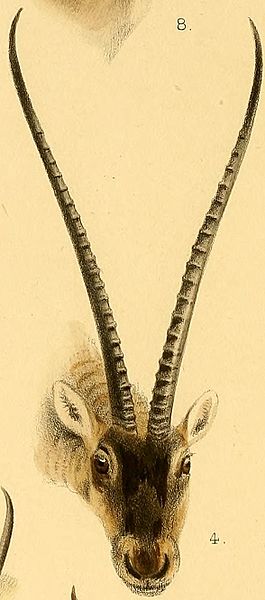Image: Head detail, Chiru of Tibet (Pantholops hodgsonii) from the book entitled, The Great and Small Game of India, Burma, and Tibet (1900) (cropped)

Description: Identifier: greatsmallgameof1900lyde (find matches) Title: The great and small game of India, Burma, & Tibet Year: 1900 (1900s) Authors: Lydekker, Richard, 1849-1915 Subjects: Hunting Hunting Hunting Mammals Publisher: London : R. Ward Contributing Library: Boston Public Library Digitizing Sponsor: Boston Public Library View Book Page: Book Viewer About This Book: Catalog Entry View All Images: All Images From Book Click here to view book online to see this illustration in context in a browseable online version of this book. Text Appearing Before Image: s species from the next were it not for importantdifferences in their skulls, that of the present animal, in addition toother points of distinction, being much more elongated. The two animals are stated to be recognised as different from oneanother by the natives of Eastern Tibet, who affirm that the presentone lives at a higher altitude than the next. Both are distinguishablefrom the Himalayan goral by the character and colour of the pelage,as well as by their longer tails. THE GREY TIBETAN GORAL (Urotragus griseus) Although it may seem somewhat curious to find two nearly alliedspecies of the same genus inhabiting the same district, yet in theopinion of Professor Milne-Edwards this goral is entitled to specificdistinction from the preceding ; and as a matter ot tact it is notuncommon to find a larger and a smaller representative of the sametype of animal in one area. The present species, which inhabits the Moupin district of Eastern Great i<L Small Game ot India &lc., Plate V. Text Appearing After Image: PLATE V la. Mishmi Takin. 6. Four-horned Antelope. za. Himalayan Serow. 7, 7^. Indian Chinkara Gazelle. 3- Goral. 8. Persian Goitred Gazelle. 4. Chiru. g. Goa Gazelle. 5. Blackbuck. 10. Nilgai. The Mishmi Takin 141 Tibet, is nearly allied to the Mongolian IJ. cai/Jatiis, from which it isdistinguished by its lighter build, shorter tail, and the deeper tint ofits fur. The upper surface of the head, together with the nasal regionand the chin, is brown with a tinge ot maroon ; while a whitish patch,which occupies the under surface of the neck, is more prolonged underthe jaw than is the case in the Mongolian species. The colour of theupper part of the body and flanks is a yellowish grey suffused withbrown, the latter tint predominating along the middle line of theback, on the front of the shoulders, and on the fore-legs and thighs.The feet are less light-coloured, while the buttocks and the innersurfaces of the legs are whiter than in the species with which thecomparison is made. The hei Note About Images Please note that these images are extracted from scanned page images that may have been digitally enhanced for readability - coloration and appearance of these illustrations may not perfectly resemble the original work.
Title: Head detail, Chiru of Tibet (Pantholops hodgsonii) from the book entitled, The Great and Small Game of India, Burma, and Tibet (1900) (cropped)
Credit: https://www.flickr.com/photos/internetarchivebookimages/14781451074/ Source book page: https://archive.org/stream/greatsmallgameof1900lyde/greatsmallgameof1900lyde#page/n180/mode/1up
Author: Lydekker, Richard, 1849-1915
Permission: At the time of upload, the image license was automatically confirmed using the Flickr API. For more information see Flickr API detail.
Usage Terms: No known copyright restrictions
License: No restrictions
License Link: https://www.flickr.com/commons/usage/
Attribution Required?: No
Image usage
The following page links to this image:

